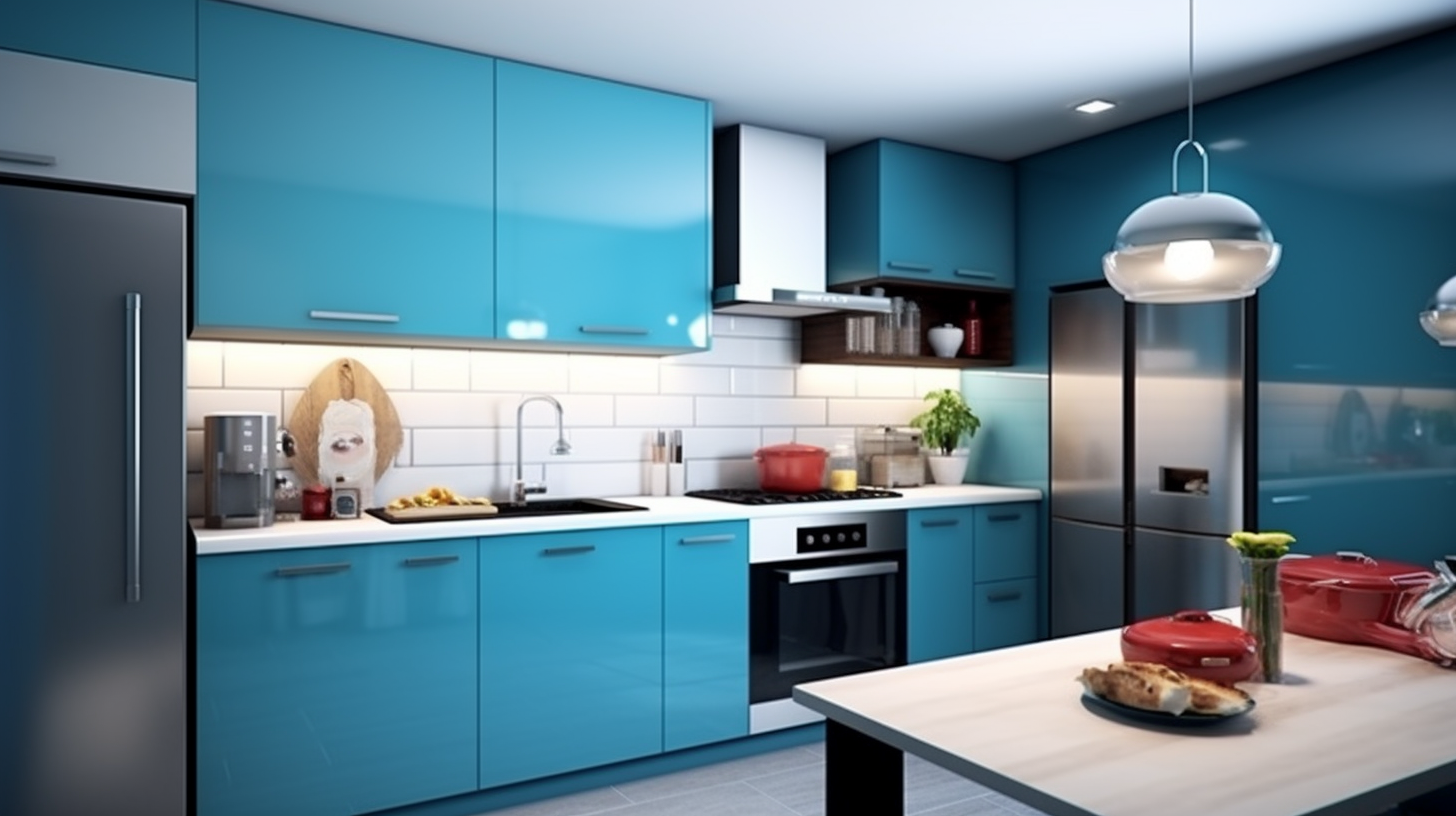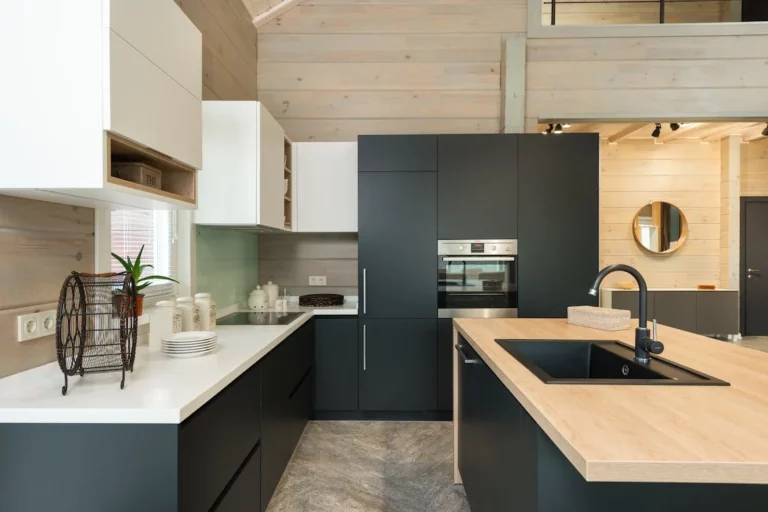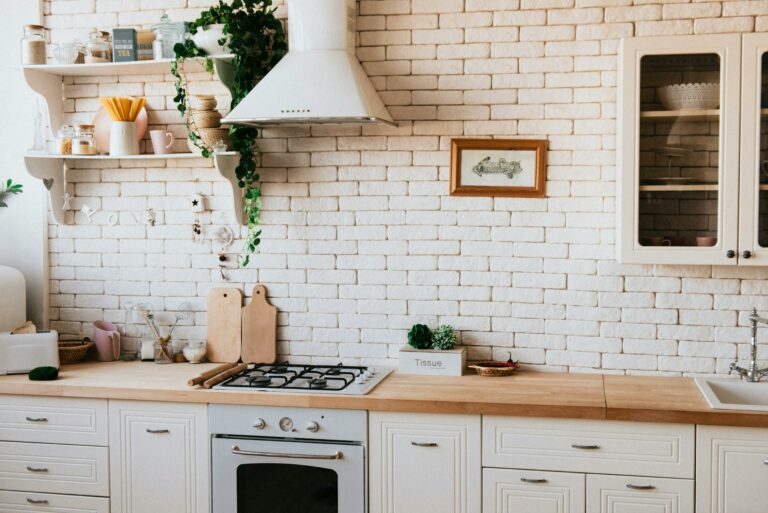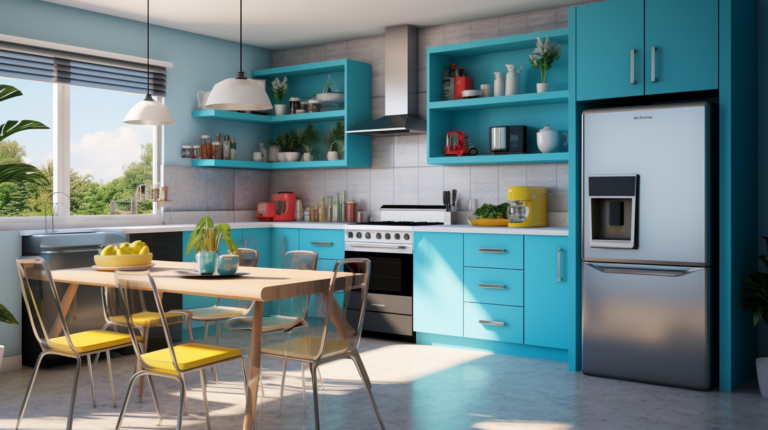Best Kitchen Renovations for Small Spaces in 2023: Maximizing Functionality
Welcome to our guide on kitchen renovations for small spaces! If you have a small kitchen, you know the struggle of trying to make the most out of limited square footage. But don’t worry, with the right strategies and design choices, you can maximize functionality and create a stylish and efficient kitchen.
Table of Contents
- 1 Kitchen Renovations for Small Spaces in 2023
- 2 Assessing Your Space
- 3 Optimizing Layout and Storage
- 4 Selecting Appliances and Fixtures
- 5 Clever Design Ideas for small spaces
- 6 Working with Professionals
- 7 Budgeting and Project Management
- 8 Safety Concerns and Regulations
- 9 Maintaining a Small Kitchen
- 10 Conclusion
- 11 Frequently Asked Questions
Kitchen Renovations for Small Spaces in 2023

In this article, we’ll walk you through everything you need to know about small kitchen renovations. We’ll cover topics such as assessing your space, optimizing layout and storage, selecting appliances and fixtures, clever design ideas, working with professionals, budgeting and project management, safety concerns and regulations, and maintaining your small kitchen.
Whether you’re dealing with a tiny apartment kitchen or a cozy galley kitchen, we’ve got you covered. So let’s dive in and discover how you can transform your small kitchen into a practical and beautiful space that you’ll love spending time in!
So why is small kitchen renovations important? Here are a few reasons to consider:
- Increased Efficiency: By optimizing the layout and storage, you can make the most of your limited space and improve workflow in the kitchen.
- Enhanced Functionality: A well-designed small kitchen can offer all the functionality of a larger kitchen, with a focus on smart storage solutions and space-saving appliances.
- Improved Aesthetics: your small kitchen renovations allows you to update the look and feel of the space, creating a more visually appealing and inviting environment.
Now that you understand the benefits of renovating your small kitchen, let’s start by assessing your space to determine what changes need to be made.
Assessing Your Space

When it comes to kitchen renovations for small spaces, the first step is to assess your current space. By understanding the limitations and dimensions of your kitchen, you can plan a renovation that maximizes functionality and makes the most of the available space. Here are a few key factors to consider:
Measuring the Kitchen
Before embarking on a kitchen renovation project, it’s essential to measure the dimensions of your kitchen accurately. This includes taking measurements of the floor area, ceiling height, walls, windows, and doors. Understanding the exact measurements will help you plan the layout and ensure that any new additions, such as cabinets or appliances, fit perfectly in the space.
Identifying Limitations
Small kitchens often come with their own set of limitations, such as limited counter space, inadequate storage, or awkward layouts. Identifying these limitations will allow you to strategize ways to overcome them during the renovation process. By taking note of any challenges your kitchen presents, you can come up with innovative solutions to make the most of the available space.
Determining Your Needs
Consider how you currently use your kitchen and what changes you would like to make to improve its functionality. Are you looking to create more storage space? Do you need to optimize the layout to make it more efficient? Determining your specific needs will help guide your renovation decisions and prioritize what improvements are most important for your small kitchen.
Take the time to brainstorm and make a list of your must-haves and nice-to-haves. This will guide you during the design process and ensure that the renovation addresses your unique needs and preferences.
“Assessing your space is the foundation of any successful kitchen renovation. By understanding the limitations, measuring accurately, and determining your needs, you can plan a renovation that maximizes functionality and makes your small kitchen work for you.”
Optimizing Layout and Storage

When it comes to kitchen renovations for small spaces, optimizing the layout and storage is key. With limited square footage, it’s important to make the most of every inch. Here are some tips and ideas to help you maximize functionality in your small kitchen:
Choosing the Right Layout
- Consider the classic galley layout, which features parallel countertops and a narrow walkway in between. This layout is perfect for small kitchens as it maximizes efficiency by placing everything within easy reach.
- Another option is the L-shaped layout, which offers more flexibility and can work well in open floor plans. It provides ample countertop space and allows for a comfortable work triangle between the sink, stove, and refrigerator.
- If you have a larger budget and more space to work with, you can also consider an island layout. This adds extra countertop and storage space, as well as a casual dining area.
Maximizing Vertical Storage
- Utilize the vertical space in your kitchen by installing tall cabinets that reach all the way up to the ceiling. This will help you make the most of the available space and provide ample storage for items that are used less frequently.
- Consider installing open shelving, which not only adds storage space but also creates a more open and airy feel in your kitchen. You can display your favorite dishes or decorative items on these shelves, adding a personal touch to the space.
- Don’t forget about the area above your cabinets. This can be a great spot to store items that are less frequently used or to display decorative pieces.
Utilizing Space-Saving Solutions
- Invest in space-saving storage solutions such as pull-out pantry shelves, corner cabinets with rotating shelves, and under-sink organizers. These will help you maximize storage while keeping everything organized and easily accessible.
- Consider installing a wall-mounted pot rack to free up cabinet space. This not only adds a unique visual element to your kitchen but also keeps your pots and pans within easy reach.
- Opt for multi-functional furniture and appliances, such as a kitchen island with built-in storage or a compact countertop oven that also functions as a microwave. These will help you make the most of your small space without sacrificing functionality.
Remember, when it comes to optimizing layout and storage in a small kitchen, it’s all about finding creative solutions and making the most of every inch. With careful planning and the right design choices, you can create a functional and beautiful kitchen that maximizes space efficiency.
Selecting Appliances and Fixtures

When it comes to selecting appliances and fixtures for your small kitchen, it’s important to prioritize functionality and space-saving features. Choosing the right appliances and fixtures can make a big difference in maximizing the efficiency and effectiveness of your limited kitchen space. Here are some tips to help you make the best choices:
Compact and Multi-functional Appliances
- Look for appliances that are specifically designed for small spaces. These compact models are often slimmer in size and have features that are tailored for efficiency.
- Consider multi-functional appliances that can perform multiple tasks. For example, a combination microwave and convection oven can save space by eliminating the need for a separate oven.
- Choose appliances that are scaled-down versions of their larger counterparts. Mini refrigerators and slimline dishwashers are great options for small kitchens.
Energy-Efficient Options
- Opt for energy-efficient appliances to not only save space but also reduce your utility bills. Look for appliances with an Energy Star rating, which signifies their energy efficiency.
- Choose appliances with smart features that allow you to monitor and control their energy usage. For example, some refrigerators have sensors that adjust the temperature based on the contents inside, reducing energy waste.
Space-Saving Fixture Design
- Select fixtures that are designed with space-saving in mind. For example, consider a fold-down faucet that can be tucked away when not in use.
- Install fixtures with integrated storage options. For instance, choose a sink with built-in countertop extensions to provide extra workspace when needed.
- Opt for under-cabinet lighting fixtures to save counter space while still providing adequate illumination.
Remember, when selecting appliances and fixtures for your small kitchen, it’s important to consider not only their size but also their functionality and energy efficiency. By making smart choices, you can make the most of your limited kitchen space without sacrificing convenience and style.
“Choosing the right appliances and fixtures can make your small kitchen feel spacious and efficient.”
Clever Design Ideas for small spaces

When it comes to designing a small kitchen, every inch of space counts. With the right design ideas, you can make your small kitchen not only functional but also stylish. Here are some clever design ideas to maximize the potential of your small kitchen:
Lighting and Color Choices
- Natural Light: Make the most of any natural light in your small kitchen. Keep windows unobstructed and use minimal window treatments to allow maximum sunlight to flood the space.
- Light Colors: Opt for light, neutral colors for your walls, cabinets, and countertops. Light colors create an illusion of space and reflect light, making the room feel bigger and brighter.
- Under Cabinet lighting: Install under cabinet lighting to brighten up your workspaces and provide additional ambient light.
Open Shelving and Glass Cabinets
- Open Shelves: Replace some upper cabinets with open shelves. Not only do open shelves make the space feel more open and airy, but they also provide easy access to frequently used items. You can showcase your beautiful dinnerware or display decorative kitchen items.
- Glass Cabinets: Consider installing glass cabinet doors to create an illusion of depth. Glass cabinets allow you to visually extend the space by showcasing what’s inside while adding a touch of elegance to your kitchen.
Utilizing Mirrors and Reflective Surfaces
- Mirrors: Strategically place mirrors in your small kitchen to create an illusion of depth. Mirrors reflect light and make the space appear larger than it actually is. Consider placing a mirror on the backsplash or on the adjacent wall.
- Reflective Surfaces: Incorporate reflective surfaces, such as stainless steel appliances or a mirrored backsplash. These surfaces bounce light around the room, making it feel more spacious.
Remember, the key to designing a small kitchen is to maximize space and create visual illusions that make the room feel larger than it actually is. By implementing these clever design ideas, you can transform your small kitchen into a functional and beautiful space.
“Design is not just what it looks like and feels like. Design is how it works.” – Steve Jobs.
Working with Professionals

When it comes to renovating a small kitchen, working with professionals can make a world of difference. They have the expertise and experience to help you navigate the challenges and maximize the potential of your space. Here are some key considerations when working with professionals for your small kitchen renovation:
Hiring a Kitchen Designer
A kitchen designer can be your best ally in creating a functional and stylish small kitchen. They have the knowledge and creativity to design a layout that optimizes space and meets your specific needs. When hiring a kitchen designer, consider the following:
- Look for designers who specialize in small kitchen renovations and have a portfolio that showcases their expertise.
- Seek recommendations from friends, family, or other professionals in the industry.
- Interview multiple designers to find someone whose style and vision align with yours.
- Discuss your budget upfront to ensure that the designer can work within your financial constraints.
Collaborating with Contractors
Once you have a design plan in place, you’ll need contractors to bring that vision to life. Here are some tips for collaborating with contractors:
- Research and interview multiple contractors to find one with experience in small kitchen renovations.
- Clearly communicate your design goals and budget to ensure that everyone is on the same page.
- Request references and check online reviews to gauge the contractor’s reliability and craftsmanship.
- Get a detailed written contract that outlines the scope of work, timeline, and payment terms.
Finding Reliable Suppliers
When it comes to sourcing materials and fixtures for your small kitchen renovation, working with reliable suppliers is essential. Here’s how to find them:
- Ask your kitchen designer or contractor for recommendations on suppliers they trust.
- Visit local showrooms to see the materials and fixtures in person before making a decision.
- Read online reviews and check customer ratings to ensure that the supplier has a good reputation.
- Compare prices from different suppliers to get the best value for your money.
Remember, communication is key when working with professionals. Be open and honest about your expectations, budget, and timeline. Regularly check-in and provide feedback to ensure that the renovation stays on track. By collaborating with professionals, you’ll have the support and expertise needed to create a small kitchen that is both functional and beautiful.
Budgeting and Project Management

When it comes to any home renovation project, budgeting and project management are essential aspects to consider. This rings especially true for kitchen renovations in small spaces. Here are some tips to help you effectively manage your budget and project:
Setting a Realistic Budget
Before diving into your kitchen renovation project, it’s crucial to establish a realistic budget. Consider the following factors when determining your budget:
- Research costs: Get an idea of the average costs associated with small kitchen renovations, including materials, labor, and any additional expenses such as permits or design fees.
- Prioritize your needs: Identify the key elements you want to focus on in your kitchen renovation. Determine what aspects are most important to you and allocate a larger portion of your budget towards them.
Prioritizing Renovations
In a small kitchen, you may not have the luxury of completely overhauling the entire space. Prioritizing renovations can help you make the most out of your budget while still achieving your desired outcome. Consider the following tips:
- Focus on functionality: Evaluate the current layout and identify any issues that hinder functionality. Addressing these concerns should be a top priority to ensure your kitchen is efficient and functional.
- Upgrade key elements: Invest in quality appliances and fixtures that will enhance your kitchen’s functionality and aesthetics. Focus on the ones you use most frequently, such as the stove or sink.
- Consider storage: Maximize your storage options by investing in clever solutions such as pull-out drawers, corner units, or overhead cabinets. Efficient storage can help you optimize your space.
Managing the Renovation Process
Managing a kitchen renovation project involves juggling multiple tasks and ensuring everything runs smoothly. Here’s how to effectively manage your project:
- Create a timeline: Establish a timeline for your project and set realistic deadlines for each phase. This will help ensure that the renovation progresses smoothly and is completed within a reasonable timeframe.
- Communicate with contractors: Maintain open and frequent communication with your contractors to stay updated on progress, address any concerns or changes, and keep the project on track.
- Keep a detailed record: Keep track of all receipts, invoices, and documentation related to your renovation project. This will help you stay organized and make it easier to monitor budget expenditures.
Remember, it’s essential to be flexible and adaptable during the renovation process, as unexpected challenges may arise. By setting a realistic budget, prioritizing renovations, and effectively managing the project, you can ensure a successful and efficient kitchen renovation within your small space.
“A detailed budget and effective project management are key to a successful kitchen renovation. Proper planning and prioritization will help you achieve your dream kitchen in a small space.”
Safety Concerns and Regulations

When renovating a small kitchen, it’s important to prioritize safety and ensure compliance with the necessary regulations. Here are some key considerations to keep in mind:
Fire Safety Precautions
- Install a smoke alarm and carbon monoxide detector in or near the kitchen to ensure early detection of potential hazards.
- Choose fire-resistant materials for your kitchen cabinets, countertops, and backsplash.
- Keep flammable items, such as curtains and paper towels, away from heat sources to minimize the risk of fire.
- Install a fire extinguisher within easy reach of the kitchen, and make sure everyone in the household knows how to use it.
Electrical and Plumbing Code Compliance
- Hire a licensed electrician and plumber to handle any electrical or plumbing work during the renovation.
- Ensure that all electrical work complies with local building codes and regulations.
- Use the correct wiring size and type for kitchen appliances to prevent overload and potential electrical hazards.
- Make sure that all outlets, switches, and wiring in the kitchen are properly grounded and meet safety standards.
- Follow plumbing codes when installing or relocating sink pipes, gas lines, or any other plumbing fixtures.
Adequate Ventilation

- Proper ventilation is essential in a kitchen to remove odors, smoke, and excess moisture.
- Install a range hood or exhaust fan to improve air quality and prevent the buildup of grease and cooking fumes.
- Ensure that your ventilation system is vented to the outside, rather than recirculating the air back into the kitchen.
- Regularly clean and maintain your ventilation system to ensure its efficiency and prevent the risk of fire or smoke buildup.
Remember, it’s crucial to consult with professionals who are knowledgeable about local building codes and regulations to ensure that your kitchen renovation meets all safety requirements. Failure to comply with these regulations can not only pose a risk to your safety but may also result in costly fines and delays in your project.
Maintaining a Small Kitchen

Congratulations on completing your kitchen renovation for a small space! Now that you have a beautifully functional kitchen, it’s important to know how to maintain it to ensure it continues to serve you well. Here are some tips on how to keep your small kitchen in top shape:
Organizational Tips
Keeping your small kitchen organized is key to maintaining its functionality and maximizing the available space. Here are some organizational tips to help you stay on top of things:
- Declutter regularly: Take the time to declutter your kitchen on a regular basis. Get rid of items that you no longer use or need to create more space.
- Organize your cabinets: Use stackable containers, drawer organizers, and shelf dividers to make the most of your cabinet space. Sort items by category and keep frequently used items within easy reach.
- Utilize wall space: Install hooks or racks on the walls to hang pots, pans, and utensils. This not only creates additional storage but also adds a charming decorative touch to your kitchen.
- Invest in storage solutions: Look for innovative storage solutions that are specifically designed for small kitchens. For example, you can install a pull-out pantry or add shelves to the inside of cabinet doors.
Regular Cleaning and Maintenance
A clean and well-maintained kitchen not only looks good but also helps prevent the build-up of dirt and grime that can affect the longevity of your kitchen. Here are some cleaning and maintenance tips for your small kitchen:
- Clean as you go: Get into the habit of cleaning up as you cook. Wipe down countertops, wash dishes, and put away ingredients immediately after use to avoid a pile-up of mess.
- Take care of appliances: Regularly clean your appliances to keep them in good working condition. Follow the manufacturer’s instructions for cleaning and maintenance.
- Deep clean on a schedule: Set aside time each month for a deep clean of your kitchen. This includes scrubbing the floors, cleaning the oven, and wiping down all surfaces.
- Keep it smelling fresh: To keep your small kitchen smelling fresh, regularly empty the trash, clean the sink and garbage disposal, and open the windows for ventilation.
Updating as Needed
With regular maintenance, small kitchen renovations may require updates and improvements over time. Here are some things to consider:
- Evaluate functionality: Assess your kitchen’s functionality periodically to identify any areas that may need improvement. Consider how your needs may have changed since the renovation and make updates accordingly.
- Stay ahead of wear and tear: Keep an eye out for any signs of wear and tear, such as peeling paint or loose cabinet handles. Address these issues promptly to prevent further damage.
- Incorporate new trends: Stay up to date with the latest kitchen trends and consider incorporating small updates to freshen up the look of your space. For example, you can swap out cabinet hardware or update the backsplash.
Remember, maintaining a small kitchen is all about staying organized, keeping things clean, and staying proactive about updates and repairs. By following these tips, your small kitchen will continue to be a functional and enjoyable space for years to come. Happy cooking!
Also read ; Architectural Wonders: Discovering Unique Home Designs in 2023
Conclusion
In conclusion, small kitchen renovations can be a challenging but rewarding endeavor. By following the tips and strategies outlined in this article, you can maximize the functionality of your kitchen and create a space that is both stylish and efficient. Remember, it’s important to assess your space, optimize the layout and storage, select the right appliances and fixtures, incorporate clever design ideas, work with professionals, manage your budget, and prioritize safety and regulations. By implementing these steps and maintaining your small kitchen, you can enjoy a beautiful and functional space for years to come.
Remember, when it comes to small kitchen renovations, every decision counts. From the layout to the lighting, every choice should be made with the goal of maximizing functionality and creating a visually appealing space. Don’t be afraid to get creative with your design ideas and think outside the box. Small kitchen renovations can be just as stylish and functional as larger ones, if not more so!
So, whether you’re redesigning a small urban apartment kitchen or revamping a cozy cottage kitchen, take the time to plan your renovations carefully. Consider your unique needs, budget, and personal style as you make decisions. And don’t forget to rely on the expertise of professionals to help guide you through the process.
Remember, small kitchen renovations does not have to feel cramped or limited. With the right renovations and design choices, you can transform your space into a functional and inviting area that you’ll love spending time in. So get started on your small kitchen renovations today and enjoy the benefits of a well-designed and efficient kitchen for years to come!
Frequently Asked Questions
- What are some key tips for maximizing functionality in a small kitchen renovations?Some key tips for maximizing functionality in a small kitchen renovations include: 1. Utilizing vertical space with shelves or wall-mounted storage, 2. Installing smart storage solutions such as pull-out cabinets or drawer organizers, 3. Choosing compact appliances, 4. Using light colors to create an illusion of space, and 5. Incorporating multi-functional furniture or accessories.
- How can I create more counter space in a small kitchen?To create more counter space in a small kitchen, you can: 1. Install a foldable or pull-out countertop extension, 2. Utilize an island or a kitchen cart with a butcher block top, 3. Mount a fold-down table or a drop-leaf table on a wall, or 4. Use a cutting board that fits over your sink.
- What are some space-saving storage solutions for a small kitchen?Some space-saving storage solutions for a small kitchen include: 1. Installing vertical racks or pegboards for hanging pots, pans, and utensils, 2. Utilizing magnetic strips or hooks for storing knives and other metal utensils, 3. Using stackable or collapsible containers for food storage, and 4. Incorporating pull-out spice racks or spice drawer organizers.
- Is it possible to have a small kitchen with an eat-in area?Yes, it is possible to have a small kitchen with an eat-in area. You can achieve this by: 1. Incorporating a small dining table or a breakfast bar that doubles as a countertop, 2. Utilizing space-saving dining furniture such as foldable chairs or benches, and 3. Creating a built-in seating nook with storage underneath.
- How can lighting enhance the functionality of a small kitchen?Proper lighting can enhance the functionality of a small kitchen by: 1. Installing under-cabinet lighting to illuminate the work area, 2. Incorporating task lighting above the stove and sink, 3. Utilizing pendant lights or track lighting to add brightness and visual interest, and 4. Making use of natural light by keeping windows unobstructed.







